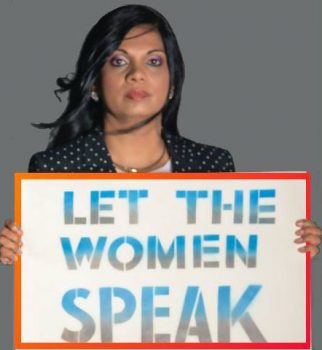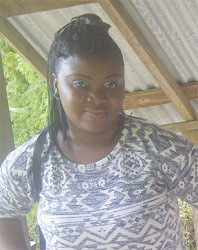Just days after what many would have considered the happiest day of her life, Donessa Barker was burnt with hot water. At the time she did not say it was her husband Miguel Barker who had burnt her, but family members suspected that it was an escalation of the man’s abuse of the young mother.
The abuse had resulted in most of her close relatives not being at her wedding. She hid the abuse, but eventually was forced to leave him. He followed her, threatened her and eventually on April 30, 2015 he murdered her at Lot 12 Inner Bagotville. It was less than a year after they were married.
The two shared a young daughter at the time.

Late last month, Barker was sentenced to 80 years in prison by Justice Navindra Singh; even after he was found guilty he had maintained his innocence. But his sentence brought closure to the relatives of Nadine, as she was fondly known, and according to her aunt Jeavon Dolphin they will now focus on ensuring that four-year-old Sade, the only child of her niece, is given the best life has to offer.
“She [the child] reminds us so much of Nadine, sometimes she walks and talks like her,” the aunt, who is the matron of the West Demerara Regional Hospital, told the Sunday Stabroek in a recent interview.
The child lives with Dolphin and her husband and their two adult children. Her grandmother, Joyien Joyce, Nadine’s mother lives overseas, but is very involved in the child’s life and her uncles also look out for her.
Describing the court proceedings, Dolphin recalled that it was the “most uncomfortable experience” for her since she had never attended court and was part of a law-abiding family.
She testified during the trial as she had witnessed the post-mortem examination of her niece and while she did not attend every day of the trial she was present when the sentence was handed down.
“I don’t know I felt, it was mixed emotions. I was glad justice was served but that cannot compensate for the loss of a life. And then I wondered why, it brought back so many memories of Nadine,” she said when asked how she felt when the man was sentenced.
Not one day did he “hang his head in shame,” Dolphin said referring to Barker, instead, he was “brass faced” and continued to maintain that he had not murdered her niece.
“He continued to deny even though the evidence was so glaring, but for me I have forgiven him because it is not worth living with him on my mind,” the hospital matron said.
The child was not taken to court as Dolphin said they did not see it as necessary and she explained that the child knows that she is not her mother.
“We told her that her mother’s name was Nadine, so she knows that and she knows that she is dead… And sometimes when we are having family conversations she would ask, ‘Was she there? Was Nadine there?’
“And one day she asked, ‘Who is my real father?’ and we just told her Alan and she smiled and we left it at that,” Dolphin continued.
She said while they are aware that a time will come when they would have to explain to the child the circumstances under which her mother died, they hope that they will find the wisdom to tell her in such a way “that she will not live with hatred.”
The relatives of her father have never reached out to Nadine’s relatives and have never attempted to see the child.
The day Dolphin received the news of her niece’s death is one she would never forget as she recalled she was in her car waiting to return to Bible Study class when she received the phone call from another niece.
“She called me and said, ‘Alan killed Nadine, I was trying to call you…’ I could not even drive after that I had to get a nephew to drive for me,” she recalled.
By that time, it was almost two hours after the young woman was killed and the next time she saw her was in the Ezekiel Funeral Home.
Dolphin recalled that Nadine was a very open-minded person who was kind and sociable. She said Nadine loved to cook and sing and “liked to look nice.”
She was the third of her mother’s five children.
She had the baby with Barker before they got married but relatives had observed his treatment of her, hence their decision not to attend the wedding.
“Twelve days after she got married she was burnt and she said a pot of water fell on her and burnt her. But when you looked at the injury you knew this was not so and she later confessed that it was him who had burnt her,” Dolphin said.
Shortly after she moved away from the house they shared but Barker followed her, and they continued the union. Eventually she decided to leave as she later stated that he had threatened to kill her several times.
A cousin still has the transcript of a Facebook conversation she had with Nadine on February 11, 2015, just about two months before she was murdered. In it, she said she had left Barker because he had threatened to killed her thrice.
“If it wasn’t for the Grace of God you woulda be coming to my funeral,” Nadine said in that conversation.
Sadly, months later, the cousin did just that.
She had related how her husband had threatened her with a hammer and told her he would kill her, chop her up and put the pieces in a bag.
After Nadine’s death, Sade’s grandmother was unable to take her overseas and she had a discussion with Dolphin’s family and they decided make the child part of their family.
“It was a hard decision because my children are adults, ages 26 and 22, and you know my freedom would be restricted because I now had a young child to take care of, but we made that decision and I have no complaint,” Dolphin said.
As Christians, Dolphin said they believed that God had a purpose and her husband agreed that they would make the sacrifice because the child did nothing to be placed in a situation where her mother was dead and her father in jail.
In her line of work, Dolphin has seen many cases of women being abused by their partners and she pleaded that women should leave those unions “because it does not make any sense.” In her niece’s case she did leave, but it was too late; she should have ended it after the first incident.
“You cover for them and then you end up being a statistic. Women have to understand their worth,” she stated.
“And abuse follows the trend when children grow up in those circumstances the vicious cycle continues, the daughter may think it is fine to be abused…” she pointed out.
She had spoken to her niece and told her that covering up for her husband was dangerous.
‘Seldom’
Meantime, while Sade is well taken care of, according to Dianne Madray, a member of the Caribbean American Domestic Violence Awareness (CADVA), an organisation that has worked with children who lost parents to abuse, the seldom seen side of domestic violence homicide is what happens to the children left behind.
“In the last two years I have recognized in my research that domestic violence murders have left a number of children orphaned without both parents. One parent is murdered and the parent, who is the perpetrator of this violent act either flees, dies by suicide or is incarcerated as in the case with Donessa Barker. The stories often hit the headlines, but seldom do we see or hear the side of the surviving children …in these homicide cases,” Madray told this newspaper.
She shared that it was difficult to determine the potential numbers of surviving children because records on domestic violence homicide do not specify if children were involved. From her research, it appears that there is limited information on what happens to these children after their parent dies.
It was in March 2016 that she began to take a closer look at the surviving children and the need for an extended support system and grief development programme.
Along with her colleague Tiffany Jackson, an advocate and former victim of domestic violence, she begun to track the number of children, and provide support and referrals, finances, supplies, mentorship, counselling and ensuring that extended families petition the courts for legal guardianship or adoption. This was necessary, especially for younger children less than three years old.
They have seen children between the ages of 15 months to age 21, who are the silent victims rarely heard about in the news. Some of them were exposed to domestic violence that likely preceded the murder.
“They have either seen actual events of physical abuse, heard the threats and sounds of loud arguing and fighting, and observed the aftermath of physical abuse such as blood, bruises, tears, torn clothing, broken items and even death of a parent by their father’s or mother’s partners,” Madray pointed out.
The children interviewed thus far, Madray said, looked fine to anyone from the outside, but on the inside, they are in pain.
“It has been noted that the children who are preschool age and younger can exhibit disrupted developmental milestones such as language development, toilet training, and motor-skills acquisition,” she further said.
She pointed out that two of the older children interviewed displayed some emotional and identity problems. And from the time of the murder of their mother to present there was no intervention or counselling services provided as a preventative measure. “In this instance, the male child seems to exhibit more aggressive behaviour, depression, severe anxiety, low self-esteem and impaired social competencies. At age 16 when questioned he does not understand why he behaves as he does,” she said.
She said while she and Jackson never met Donessa Barker, her family will continue to receive support as needed.
“We will continue to monitor the child of Ms Barker. Along with the extended family, we will provide any necessary and needed support that this young child requires to develop a normal upbringing as possible,” she continued.










